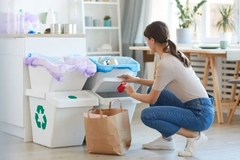Britvic boosts vitamin drinks with Xampla’s UV ray resistant microcapsules

17 Feb 2022 --- Britvic is teaming up with University of Cambridge spin-off Xampla in a £1 million (US$1.36 million) packaging innovation partnership, supplying consumers with pea protein-based vitamin microcapsules. The capsules are ultraviolet (UV) ray resistant and can enhance plastic bottle recyclability.
Xampla says the product represents the “world’s first” commercialized plant protein material for making microscopic capsules that protect vitamins within liquid, preventing them from being broken down by sunlight.
Innovate UK, the UK government’s innovation agency, has injected £1 million (US$1.36 million) into the company to support the scaling up of its technology and material processing.
Simon Hombersley, Xampla’s CEO, tells PackagingInsights: “This [product] enables brands to use clear packaging that lets in UV rays without damaging the vitamins, as they are already protected in Xampla’s innovative micro packaging within the liquid itself.”
“This [solution] means that brands do not have to sacrifice their packaging of choice to deliver the maximum amount of vitamins to consumers.”
Clear bottle boost
Xampla’s new partner Britvic says the innovation is “critical” to delivering drinks fortified with vitamins in clear plastic bottles. Clear plastic bottles are considered widely recyclable through consumer recycling streams, with Britvic’s research showing people are 40% more likely to recycle clear bottles over colored ones.
 Clear bottles are easier to sort and therefore more likely to be recycled.However, the downside of clear bottles is that they let more UV rays in, reducing vitamin D protection.
Clear bottles are easier to sort and therefore more likely to be recycled.However, the downside of clear bottles is that they let more UV rays in, reducing vitamin D protection.
“Clear bottles are easier to sort during the recycling process, which means they are more likely to be recycled into clear plastic to be used for another bottle,” explains Hombersley. “In contrast, darker or dyed plastics are more challenging to turn into clear plastic for reuse and they tend to be recycled into other items including clothing, playground equipment or garden furniture.”
“Xampla’s technology can be used in the liquid of a product inside any bottle color but the innovation is especially exciting when we consider clear plastic packaging and the challenge this presents for vitamins being exposed to UV rays.”
Meeting consumer demand
Xampla and Britvic will jointly develop new formats for nutrients to meet consumer demand. The partnership forms part of Britvic’s “Healthier People, Healthier Planet” strategy.
Hombersley says Xampla’s ambition is to make it easier for Britvic to answer the demands of its consumers for more nutrients to be added to their favorite drinks, without the risk of vitamins degrading within liquid during transit and on the shelf.
“For Xampla, this is a new application for our pea-protein product. We’re not replacing plastic here but instead offering completely new technology. These tiny microcapsules could represent a big step forward in both public and planetary health,” he says.
 Xampla’s technology allows brands to use clear packaging that protest vitamins against UV rays.In the news
Xampla’s technology allows brands to use clear packaging that protest vitamins against UV rays.In the news
Last year, the University of Cambridge researchers developed a plant protein-based biomaterial that can replace synthetic materials and virgin polymers. The material is biodegradable and as strong as conventional plastic.
Xampla also partnered with UK recipe box service Gousto, trialing an edible wrapper made from pea protein and potato starch for bouillon cubes. The cubes and their packaging dissolve in hot water and replace stock mix sachets.
Meanwhile, Britvic transitioned its green 7UP bottles to a clear, transparent PET to encourage consumer recycling. In 2020, Britvic conducted consumer research confirming a switch in color would improve both sales and recycling practices among its consumer base.
Also, Britvic moved its Robinsons, Lipton Ice Tea and Drench 500 mL beverage bottles to 100 percent recycled PET (rPET). The on-the-go bottles are the first to use recycled plastic from a new rPET manufacturing facility in North Yorkshire, UK.
Furthermore, Britvic announced plans to phase out all non-recycled plastic in its bottles before 2023. The British soft drinks producer will transition to 100% rPET, doubling its original plan to achieve 50% rPET by 2025 and bringing the target forward by three years.
By Natalie Schwertheim











